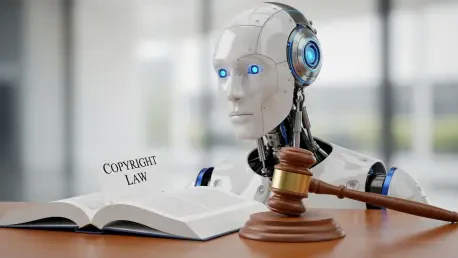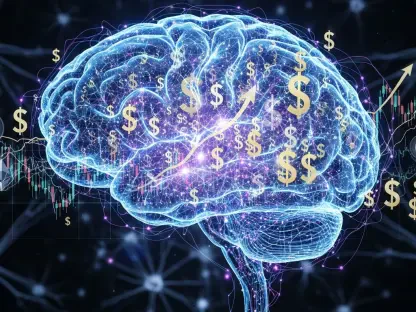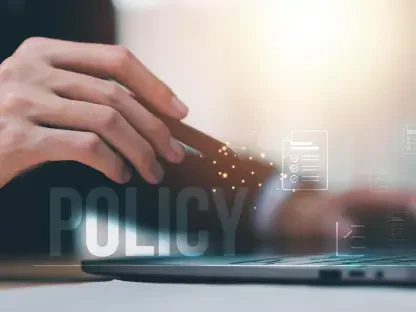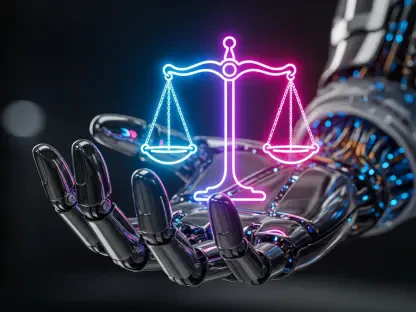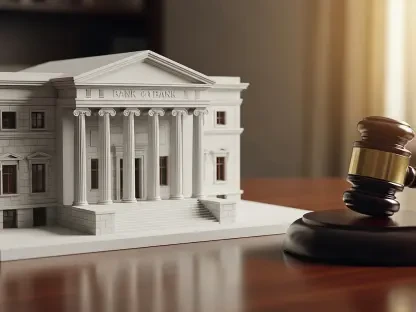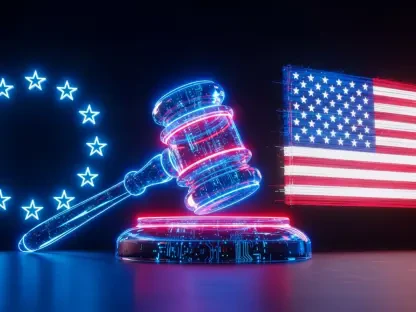The rapid integration of artificial intelligence into creative industries has transformed the way content is produced, but it comes with a hidden cost that many fail to recognize. A staggering number of businesses leveraging AI tools for marketing, art, and software development are unaware of the legal pitfalls surrounding copyright infringement, putting them at significant risk. As generative AI platforms become indispensable, the danger of unintentionally violating intellectual property rights looms large, threatening financial and reputational damage. This report delves into the complex intersection of AI and copyright law, exploring the challenges, legal uncertainties, and actionable strategies to navigate this evolving landscape. With insights from industry trends and regulatory frameworks, the focus is on equipping stakeholders with the knowledge to balance innovation with compliance.
Understanding the AI and Intellectual Property Landscape
Artificial intelligence, particularly generative tools like ChatGPT, Google’s Gemini, and Anthropic’s Claude, has become a cornerstone of creative and commercial industries. These platforms, powered by large language models, enable businesses to automate content creation, streamline software development, and produce visual art at unprecedented speeds. From advertising campaigns to code generation, AI’s influence spans diverse sectors, reshaping workflows and reducing operational costs. However, this technological leap forward raises critical questions about the protection of original works in an era where machines can replicate human creativity.
Intellectual property, especially copyright, serves as the bedrock for safeguarding creative output, ensuring that creators retain control over their work. The intersection of AI and IP has become increasingly complex as these tools often rely on vast datasets that may include copyrighted material for training purposes. This creates a tension between technological advancement and legal boundaries, with businesses caught in the middle. The stakes are high, as infringement can lead to costly litigation and loss of trust in a competitive market.
Key players in this space include AI developers like OpenAI and Stability AI, alongside enterprises adopting these tools for efficiency. The technological dominance of large language models drives innovation but also amplifies the risk of legal disputes over content ownership and originality. In the United States, copyright law under Title 17 of the U.S. Code provides a foundational regulatory framework, yet its application to AI-generated content remains ambiguous. This uncertainty underscores the need for clarity as industries continue to embrace AI at scale.
Trends and Developments in AI and Copyright Law
Emerging Challenges with AI-Generated Content
The adoption of AI tools has surged across sectors such as marketing, where firms use them to draft campaigns, and software development, where code is generated in minutes. Artists, too, rely on AI to create visuals, tapping into its ability to mimic styles or generate novel designs. This rapid integration is driven by a market demand for cost efficiency, as AI reduces the need for extensive human labor while delivering quick results. Yet, this trend brings with it a host of ethical and legal debates that are reshaping industry norms.
One pressing concern is the use of copyrighted data to train AI models, which can lead to outputs that unintentionally replicate protected works. As users increasingly depend on AI for content creation, the potential for infringement grows, especially when outputs mirror existing material too closely. This issue is compounded by the lack of transparency in how AI systems process and utilize training data, leaving users vulnerable to legal challenges despite their reliance on technology for innovation.
While AI presents opportunities for groundbreaking content creation, it also introduces risks of disputes that could stifle progress. Businesses may face lawsuits over outputs deemed derivative, even as they seek to leverage AI for competitive advantage. Balancing these opportunities with the inherent risks requires a deeper understanding of legal implications and a proactive approach to content vetting, ensuring that innovation does not come at the expense of compliance.
Legal Uncertainties and Ongoing Litigation
The legal landscape surrounding AI and copyright remains murky, particularly when it comes to fair use and transformative use doctrines. Under U.S. law, fair use allows limited reproduction of copyrighted material for purposes like criticism or education, but its application to AI training and outputs is far from settled. Some argue that training on copyrighted data is transformative, as it serves a different purpose than the original content, while others see it as unauthorized use for commercial gain, sparking heated debates.
High-profile lawsuits, such as The New York Times v. OpenAI and Getty Images v. Stability AI, highlight the growing tension between AI developers and content creators. These cases, which address issues of data scraping and output similarity, serve as critical indicators of where the law might head. Their outcomes could redefine how AI companies operate, potentially imposing stricter guidelines on data usage or mandating licensing agreements to avoid infringement claims.
Looking ahead, court rulings in these cases may establish precedents that shape the future of AI and IP law over the next few years, from the current year to 2027. Such decisions are likely to spur growth in risk mitigation services, as businesses seek legal consulting to navigate uncertainties. The evolving nature of litigation suggests that industries must prepare for tighter regulations and invest in strategies to minimize exposure to legal challenges.
Key Risks and Challenges of AI in Copyright Protection
The potential for AI-generated content to be classified as derivative works poses a significant risk to users. If an output closely resembles copyrighted material, it could be deemed a violation, even if the similarity was unintended. This danger is particularly acute in creative fields where specific expressions, rather than broad ideas, are protected under U.S. law, making businesses liable for content that mirrors existing works too closely.
Another challenge lies in the opaque nature of AI training data, which users cannot access or control. This lack of transparency increases the likelihood of unintentional infringement, as individuals and companies have no way to verify whether the AI has drawn from protected sources. The absence of user oversight over these processes means that even well-intentioned applications of AI can result in legal repercussions, heightening the need for caution.
Ownership complexities further complicate the issue, as purely AI-generated content may not qualify for copyright protection under current U.S. guidelines due to the lack of human authorship. This leaves users vulnerable, unable to claim rights over their outputs while still facing liability for potential infringements. To address these risks, initial solutions include raising awareness of copyright issues, using plagiarism detection tools, and crafting AI prompts carefully to avoid replicating protected material, thereby reducing exposure to disputes.
Navigating the Regulatory Landscape for AI and IP
U.S. copyright law, particularly the fair use doctrine under 17 U.S.C. § 107, provides a framework for assessing the legality of using copyrighted material, yet its application to AI remains ambiguous. Factors such as the purpose of use, the amount of material used, and the effect on the market value of the original work are considered, but how these apply to AI training data and outputs is unclear. This uncertainty creates a challenging environment for businesses seeking to comply with existing regulations.
The U.S. Copyright Office has taken a firm stance that content generated solely by machines lacks the human authorship required for copyright eligibility. This position means that unedited AI outputs may not be protected, placing users in a precarious position where they bear responsibility for infringement without owning the rights to their creations. Such rulings highlight the gaps in current laws when addressing technology-driven content production.
Ongoing litigation is expected to influence regulatory clarity, potentially leading to new standards or amendments tailored to AI-specific challenges. Until then, businesses must prioritize compliance by conducting legal reviews of AI-generated content and establishing internal policies to mitigate risks. These measures, while resource-intensive, are essential for avoiding costly legal battles and maintaining trust with stakeholders in a rapidly changing regulatory landscape.
Future Outlook for AI and Copyright Law Integration
The trajectory of AI and copyright law integration points toward significant shifts driven by potential court precedents. Rulings in current cases could redefine fair use or extend protections to stylistic elements in creative works, fundamentally altering how AI tools are developed and used. Such legal developments are poised to create a more structured environment, offering clearer guidelines for industries reliant on generative technologies.
Emerging technologies, like advanced plagiarism detection tools, are expected to play a pivotal role in supporting copyright compliance. These solutions can help identify similarities between AI outputs and existing works before publication, reducing infringement risks. Additionally, there is a noticeable shift in consumer and business preferences toward ethical AI use, with growing demand for transparent practices and legal frameworks that prioritize creator rights alongside innovation.
Global economic and regulatory factors, including international IP agreements, are likely to influence U.S. policies in the coming years. Harmonizing standards across borders could impact how domestic industries approach AI adoption, encouraging collaboration on best practices. As these dynamics unfold, staying ahead of regulatory trends will be crucial for businesses aiming to leverage AI while minimizing legal exposure in a globally connected market.
Conclusion and Recommendations for Stakeholders
Reflecting on the insights gathered, it is clear that the dual uncertainty of ownership and liability risks dominates discussions around AI-generated content. The legal gray areas surrounding fair use and transformative use have left businesses navigating uncharted territory, often without adequate protection. These challenges underscore the delicate balance that must be struck between fostering AI innovation and upholding copyright protections.
Moving forward, stakeholders are encouraged to take proactive steps by educating employees on copyright fundamentals and integrating legal oversight into AI-driven workflows. Adopting risk management tools, such as plagiarism detectors, offers a practical way to flag potential issues early. Investment in legal tech solutions and training programs also emerges as a promising avenue, equipping organizations to handle complexities with confidence. By focusing on these actionable measures, industries can pave the way for sustainable growth in an AI-driven era, ensuring that creativity and compliance go hand in hand.
